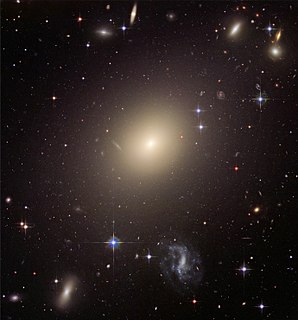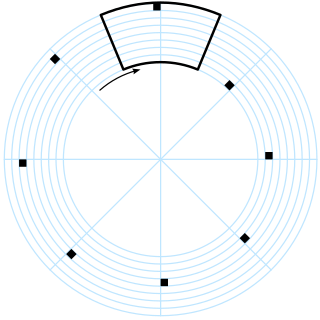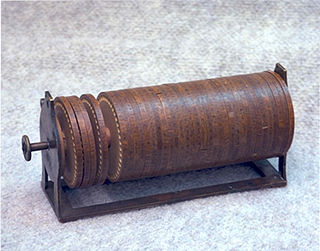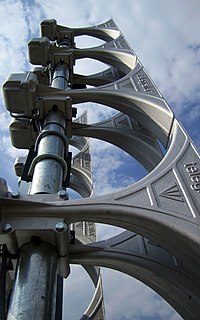
A black hole is a region of spacetime where gravity is so strong that nothing – no particles or even electromagnetic radiation such as light – can escape from it. The theory of general relativity predicts that a sufficiently compact mass can deform spacetime to form a black hole. The boundary of no escape is called the event horizon. Although it has a great effect on the fate and circumstances of an object crossing it, it has no locally detectable features according to general relativity. In many ways, a black hole acts like an ideal black body, as it reflects no light. Moreover, quantum field theory in curved spacetime predicts that event horizons emit Hawking radiation, with the same spectrum as a black body of a temperature inversely proportional to its mass. This temperature is of the order of billionths of a kelvin for stellar black holes, making it essentially impossible to observe directly.

A floppy disk or floppy diskette is an obsolete type of disk storage composed of a thin and flexible disk of a magnetic storage medium in a square or nearly square plastic enclosure lined with a fabric that removes dust particles from the spinning disk. Floppy disks store digital data which can be read and written when the disk is inserted into a floppy disk drive (FDD) connected to or inside a computer or other device.
The Schwarzschild radius or the gravitational radius is a physical parameter in the Schwarzschild solution to Einstein's field equations that corresponds to the radius defining the event horizon of a Schwarzschild black hole. It is a characteristic radius associated with any quantity of mass. The Schwarzschild radius was named after the German astronomer Karl Schwarzschild, who calculated this exact solution for the theory of general relativity in 1916.

An elliptical galaxy is a type of galaxy with an approximately ellipsoidal shape and a smooth, nearly featureless image. They are one of the four main classes of galaxy described by Edwin Hubble in his Hubble sequence and 1936 work The Realm of the Nebulae, along with spiral and lenticular galaxies. Elliptical (E) galaxies are, together with lenticular galaxies (S0) with their large-scale disks, and ES galaxies with their intermediate scale disks, a subset of the "early-type" galaxy population.

Phosphorescence is a type of photoluminescence related to fluorescence. When exposed to light (radiation) of a shorter wavelength, a phosphorescent substance will glow, absorbing the light and reemitting it at a longer wavelength. Unlike fluorescence, a phosphorescent material does not immediately reemit the radiation it absorbs. Instead, a phosphorescent material absorbs some of the radiation energy and reemits it for a much longer time after the radiation source is removed.

A Nipkow disk, also known as scanning disk, is a mechanical, rotating, geometrically operating image scanning device, patented in 1885 by Paul Gottlieb Nipkow. This scanning disk was a fundamental component in mechanical television, and thus the first televisions, through the 1920s and 1930s.

The Kerr metric or Kerr geometry describes the geometry of empty spacetime around a rotating uncharged axially-symmetric black hole with a quasispherical event horizon. The Kerr metric is an exact solution of the Einstein field equations of general relativity; these equations are highly non-linear, which makes exact solutions very difficult to find.

The Jefferson disk, also called the Bazeries Cylinder or wheel cypher as named by Thomas Jefferson, is a cipher system using a set of wheels or disks, each with the 26 letters of the alphabet arranged around their edge. The order of the letters is different for each disk and is usually ordered randomly. Each disk is marked with a unique number and a hole in the center of the disks allows them to be stacked on an axle. The disks are removable and can be mounted on the axle in any order desired. The order of the disks is the cipher key, and both sender and receiver must arrange the disks in the same predefined order. Jefferson's device had 36 disks.

A siren is a loud noise-making device. Civil defense sirens are mounted in fixed locations and used to warn of natural disasters or attacks. Sirens are used on emergency service vehicles such as ambulances, police cars, and fire trucks. There are two general types: mechanical and electronic.

An astrophysical jet is an astronomical phenomenon where outflows of ionised matter are emitted as an extended beam along the axis of rotation. When this greatly accelerated matter in the beam approaches the speed of light, astrophysical jets become relativistic jets as they show effects from special relativity.
The Ehrenfest paradox concerns the rotation of a "rigid" disc in the theory of relativity.

The Penrose process is theorised by Sir Roger Penrose as a means whereby energy can be extracted from a rotating black hole. The process takes advantage of the ergosphere --- a region of spacetime around the black hole dragged by its rotation faster than the speed of light, meaning that from the point of an outside observer any matter inside is forced to move in the direction of the rotation of the black hole.
Mellon optical memory was an early form of computer memory invented at the Mellon Institute in 1951. The device used a combination of photoemissive and phosphorescent materials to produce a "light loop" between two surfaces. The presence or lack of light, detected by a photocell, represented a one or zero. Although promising, the system was rendered obsolete with the introduction of magnetic-core memory in the early 1950s. It appears that the system was never used in production.

Gamma-ray burst progenitors are the types of celestial objects that can emit gamma-ray bursts (GRBs). GRBs show an extraordinary degree of diversity. They can last anywhere from a fraction of a second to many minutes. Bursts could have a single profile or oscillate wildly up and down in intensity, and their spectra are highly variable unlike other objects in space. The near complete lack of observational constraint led to a profusion of theories, including evaporating black holes, magnetic flares on white dwarfs, accretion of matter onto neutron stars, antimatter accretion, supernovae, hypernovae, and rapid extraction of rotational energy from supermassive black holes, among others.
The following outline is provided as an overview of and topical guide to black holes:

Retrograde motion in astronomy is, in general, orbital or rotational motion of an object in the direction opposite the rotation of its primary, that is, the central object. It may also describe other motions such as precession or nutation of an object's rotational axis. Prograde or direct motion is more normal motion in the same direction as the primary rotates. However, "retrograde" and "prograde" can also refer to an object other than the primary if so described. The direction of rotation is determined by an inertial frame of reference, such as distant fixed stars.

In astrophysics, an event horizon is a boundary beyond which events cannot affect an observer. Wolfgang Rindler coined the term in the 1950s.

NGC 660 is a peculiar and unique polar-ring galaxy located approximately 45 million light-years from Earth in the Pisces constellation. It is the only such galaxy having, as its host, a "late-type lenticular galaxy". It was probably formed when two galaxies collided a billion years ago. However, it may have first started as a disk galaxy that captured matter from a passing galaxy. This material could have, over time, become "strung out" to form a rotating ring.

NGC 4138 is the New General Catalogue identifier for a lenticular galaxy in the northern constellation of Canes Venatici. Located around 52 million light years from Earth, it spans some 2.1 × 1.3 arc minutes and has an apparent visual magnitude of 11.3. The morphological classification of NGC 4138 is SA0+(r), indicating it lacks a bar formation and has tightly wound spiral arms with a ring-like structure around the nucleus. It has no nearby companion galaxies.

NGC 3147 is a spiral galaxy located in the constellation Draco. It is located at a distance of circa 130 million light years from Earth, which, given its apparent dimensions, means that NGC 3147 is about 140,000 light years across. It was discovered by William Herschel on April 3, 1785. It is a Type II Seyfert galaxy.















